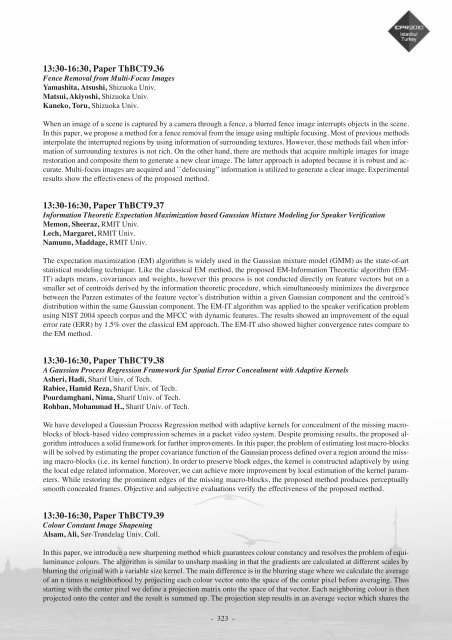Abstract book (pdf) - ICPR 2010
Abstract book (pdf) - ICPR 2010
Abstract book (pdf) - ICPR 2010
- TAGS
- abstract
- icpr
- icpr2010.org
Create successful ePaper yourself
Turn your PDF publications into a flip-book with our unique Google optimized e-Paper software.
13:30-16:30, Paper ThBCT9.36<br />
Fence Removal from Multi-Focus Images<br />
Yamashita, Atsushi, Shizuoka Univ.<br />
Matsui, Akiyoshi, Shizuoka Univ.<br />
Kaneko, Toru, Shizuoka Univ.<br />
When an image of a scene is captured by a camera through a fence, a blurred fence image interrupts objects in the scene.<br />
In this paper, we propose a method for a fence removal from the image using multiple focusing. Most of previous methods<br />
interpolate the interrupted regions by using information of surrounding textures. However, these methods fail when information<br />
of surrounding textures is not rich. On the other hand, there are methods that acquire multiple images for image<br />
restoration and composite them to generate a new clear image. The latter approach is adopted because it is robust and accurate.<br />
Multi-focus images are acquired and ``defocusing’’ information is utilized to generate a clear image. Experimental<br />
results show the effectiveness of the proposed method.<br />
13:30-16:30, Paper ThBCT9.37<br />
Information Theoretic Expectation Maximization based Gaussian Mixture Modeling for Speaker Verification<br />
Memon, Sheeraz, RMIT Univ.<br />
Lech, Margaret, RMIT Univ.<br />
Namunu, Maddage, RMIT Univ.<br />
The expectation maximization (EM) algorithm is widely used in the Gaussian mixture model (GMM) as the state-of-art<br />
statistical modeling technique. Like the classical EM method, the proposed EM-Information Theoretic algorithm (EM-<br />
IT) adapts means, covariances and weights, however this process is not conducted directly on feature vectors but on a<br />
smaller set of centroids derived by the information theoretic procedure, which simultaneously minimizes the divergence<br />
between the Parzen estimates of the feature vector’s distribution within a given Gaussian component and the centroid’s<br />
distribution within the same Gaussian component. The EM-IT algorithm was applied to the speaker verification problem<br />
using NIST 2004 speech corpus and the MFCC with dynamic features. The results showed an improvement of the equal<br />
error rate (ERR) by 1.5% over the classical EM approach. The EM-IT also showed higher convergence rates compare to<br />
the EM method.<br />
13:30-16:30, Paper ThBCT9.38<br />
A Gaussian Process Regression Framework for Spatial Error Concealment with Adaptive Kernels<br />
Asheri, Hadi, Sharif Univ. of Tech.<br />
Rabiee, Hamid Reza, Sharif Univ. of Tech.<br />
Pourdamghani, Nima, Sharif Univ. of Tech.<br />
Rohban, Mohammad H., Sharif Univ. of Tech.<br />
We have developed a Gaussian Process Regression method with adaptive kernels for concealment of the missing macroblocks<br />
of block-based video compression schemes in a packet video system. Despite promising results, the proposed algorithm<br />
introduces a solid framework for further improvements. In this paper, the problem of estimating lost macro-blocks<br />
will be solved by estimating the proper covariance function of the Gaussian process defined over a region around the missing<br />
macro-blocks (i.e. its kernel function). In order to preserve block edges, the kernel is constructed adaptively by using<br />
the local edge related information. Moreover, we can achieve more improvement by local estimation of the kernel parameters.<br />
While restoring the prominent edges of the missing macro-blocks, the proposed method produces perceptually<br />
smooth concealed frames. Objective and subjective evaluations verify the effectiveness of the proposed method.<br />
13:30-16:30, Paper ThBCT9.39<br />
Colour Constant Image Shapening<br />
Alsam, Ali, Sør-Trøndelag Univ. Coll.<br />
In this paper, we introduce a new sharpening method which guarantees colour constancy and resolves the problem of equiluminance<br />
colours. The algorithm is similar to unsharp masking in that the gradients are calculated at different scales by<br />
blurring the original with a variable size kernel. The main difference is in the blurring stage where we calculate the average<br />
of an n times n neighborhood by projecting each colour vector onto the space of the center pixel before averaging. Thus<br />
starting with the center pixel we define a projection matrix onto the space of that vector. Each neighboring colour is then<br />
projected onto the center and the result is summed up. The projection step results in an average vector which shares the<br />
- 323 -



